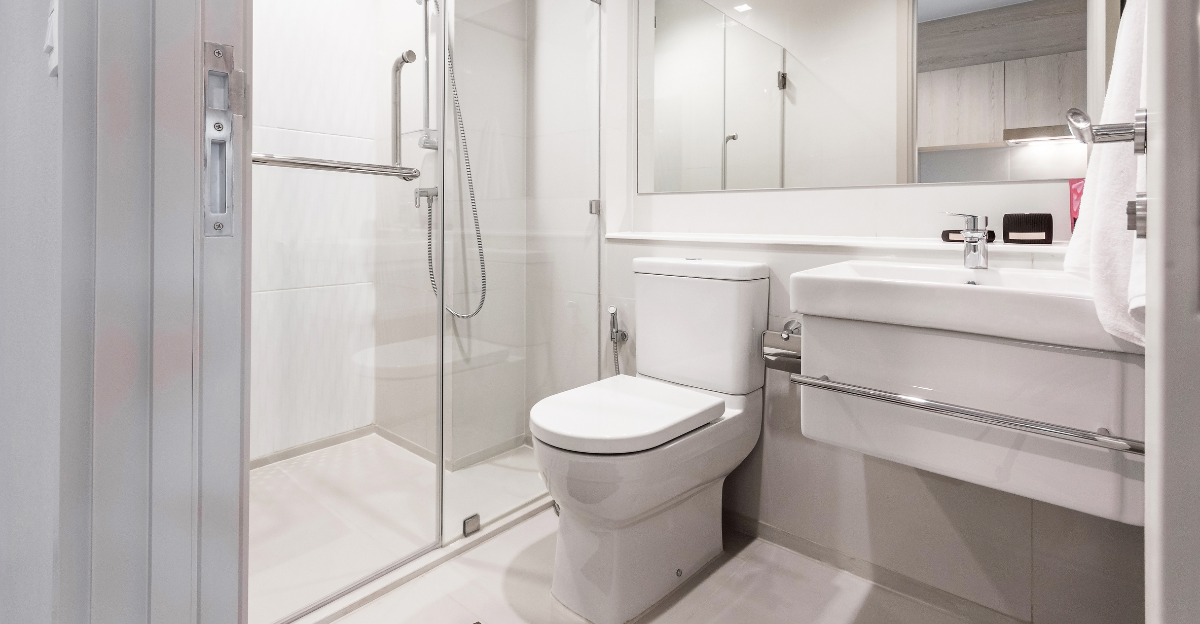Bathroom design trends are constantly evolving, and what once seemed modern can quickly feel tired and outdated. As we approach 2026, several popular bathroom looks from recent years are already losing their appeal among homeowners and designers alike. Understanding which styles are on their way out can help you make smarter renovation choices and keep your bathroom feeling fresh and current for years to come.
1. LED Mood (Colored) Lighting
Remember when colorful LED strips seemed like the coolest way to jazz up your bathroom? Those days are fading fast. Designers are moving away from the nightclub vibe that colored mood lighting creates, preferring instead warm, natural illumination that feels calming and spa-like.
The problem with rainbow LEDs is they can make your bathroom feel more like a gaming setup than a relaxing retreat. Plus, they often cast unflattering colors on skin tones, making it harder to apply makeup or groom properly.
Homeowners are now choosing adjustable white lighting with dimming capabilities. This approach offers flexibility without the gimmicky feel that colored lights bring to the space.
2. Wet Rooms
Wet rooms took the design world by storm with their sleek, barrier-free aesthetic. The concept of an entirely open, waterproofed bathroom seemed ultra-modern and luxurious. However, practical concerns are causing many homeowners to reconsider this trend.
The reality is that wet rooms require meticulous waterproofing and constant maintenance. Water splashes everywhere, creating slip hazards and making the entire bathroom feel damp and humid. Ventilation becomes a major challenge, often leading to mold issues.
Bathrooms with defined shower zones are making a comeback. People want containment without sacrificing style, opting for frameless glass enclosures that offer the best of both worlds—openness with practical boundaries.
3. Sterile Fixtures
Wire shelving and metal-framed mirrors once symbolized industrial chic and modern minimalism. Fast forward to today, and these sterile fixtures are making bathrooms feel more like hospital rooms than personal sanctuaries. The overly clinical look has lost its charm.
Cold metal finishes lack the warmth that makes a bathroom inviting. These fixtures also tend to show water spots, rust, and wear quickly, requiring constant cleaning to maintain their appearance.
Warmer materials like wood accents, brushed brass, and matte black fixtures are taking over. These choices add personality and comfort while still maintaining a contemporary edge that feels lived-in rather than sterile.
4. Feature Shower Niches
Elaborate shower niches with contrasting tiles, LED backlighting, and intricate designs became Instagram favorites. Homeowners invested heavily in these statement features, treating them as focal points. But the trend is quickly becoming yesterday’s news.
These over-designed niches often clash with simpler, more timeless bathroom aesthetics. They require extra maintenance, with grout lines collecting soap scum and the decorative elements feeling too busy for modern tastes.
Simple, functional recessed shelving is the new preference. Clean lines and matching tile create seamless storage without drawing unnecessary attention. The goal is practicality that blends in rather than stands out awkwardly in your shower space.
5. Plain Standard Tile Patterns
Basic subway tiles laid in standard grid patterns dominated bathrooms for years because they were safe, affordable, and easy to install. While there’s nothing inherently wrong with simplicity, the predictable look has become uninspiring and forgettable.
Homeowners are craving more visual interest and personality in their spaces. Standard patterns feel generic, like something you’d find in every apartment building or budget hotel renovation.
Creative tile layouts like herringbone, vertical stacking, or mixed sizes are gaining popularity. Even using the same classic tiles, different patterns can transform a bathroom from boring to beautiful. Texture and dimension matter more than ever in creating spaces with character and distinction.
6. Loud Busy Tile Designs
Bold geometric patterns and vibrant mosaic tiles exploded onto the scene as statement-makers. The more eye-catching, the better seemed to be the motto. But maximalist tile designs are quickly exhausting homeowners who crave visual peace in their private spaces.
These busy patterns can make small bathrooms feel cramped and chaotic. What seems exciting initially often becomes overwhelming when you’re confronted with it every single day. Resale value suffers too, as personalized bold choices rarely appeal to future buyers.
Subtle texture and neutral tones are replacing loud patterns. Think natural stone looks, soft terrazzo, or gentle variations that add interest without screaming for attention in your sanctuary.
7. Open Shelving for Towels
Open shelving promised to make bathrooms feel airy and hotel-like, with perfectly folded towels on display. Social media made this look seem effortless and elegant. Reality, however, tells a different story that most homeowners eventually discover.
Towels collect dust, moisture causes mildew, and maintaining that picture-perfect arrangement requires constant effort. Bathrooms generate humidity that affects everything left exposed, creating maintenance headaches rather than the relaxed vibe people hoped for.
Enclosed storage with good ventilation is making a strong return. Linen closets, closed cabinets, and hidden storage keep towels fresh while maintaining clean visual lines. Function is winning over the staged perfection that open shelving demands daily.
8. All-White Bathrooms
All-white bathrooms represented cleanliness, simplicity, and timeless elegance for decades. The monochromatic look seemed foolproof and universally appealing. But the tide is turning as people seek warmth and personality in their most personal spaces.
Pure white can feel cold, institutional, and lacking in character. Every smudge, stain, and imperfection shows immediately, creating a high-maintenance situation. The stark environment offers no visual warmth or comfort.
Layered neutrals with varied textures are the new sophisticated choice. Creams, beiges, soft grays, and natural wood tones create depth while remaining timeless. Adding dimension through materials rather than relying solely on white makes bathrooms feel genuinely inviting and thoughtfully designed.








